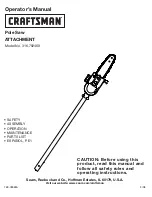
-9-
VARIABLE SPEED CONTROLLED
TRIGGER SWITCH
Your tool is equipped with a variable speed
controlled trigger switch. The tool can be
turned "ON" or "OFF" by squeezing or
releasing the trigger. The blade plunger stroke
rate can be adjusted from the minimum to
maximum nameplate stroke rate by the
pressure you apply to the trigger. Apply more
pressure to increase the speed and release
pressure to decrease speed (Fig. 1).
USING THE SAW
1. Securely clamp the work.
2. Mark the line of cut and grasp the tool with
one hand on the handle and the other
placed on the insulated rubber boot over
the front housing.
Always hold the saw by the
insulated boot on the front
housing.
If you saw into a blind area where
live wiring exists, you may be shocked or
electrocuted.
3. Keep the saw footplate firmly against the
work to minimize counter-force (jumping)
and vibration.
4. Squeeze the trigger to start the tool. Let the
saw reach full speed before starting the cut.
Guide the saw so that the blade will move
along the marked line.
SAWING TIPS
Following a few simple tips will reduce the
wear on the workpiece, the tool and the
operator.
1. Blades cut on the draw or back stroke. On
fine work, such as paneling, fiberglass, etc.,
place the good side of workpiece facing
down.
2. Use the correct saw blade for the material
being cut and keep extra blades on hand to
use when others become dull. Replace
cracked or bent blades immediately.
3. Select the appropriate cutting speed.
To reduce the risk of injury,
be sure the blade always
extends beyond the footplate and work
throughout the stroke.
Blades may shatter if
the front on the blade hits the work and/or the
footplate.
4. When cutting metal:
- Apply a lubricant for easier, smoother,
faster cutting and longer blade life.
- For non-ferrous metals, aluminum,
bronze or brass, use a stick wax on the
blade.
- For ferrous metals, iron and steel, use
machine or cutting oil along the surface
to be cut.
5. When cutting thin metal, "sandwich" the
material between two pieces of scrap wood.
Clamp or put in a bench vise. One piece of
lumber on top of the metal can be used with
adequate clamping. Place your cut lines or
design on the wood.
6. Don’t force the cutting. Let the saw and
blade do the work.
When operating the saw
continuously and for
prolonged periods of time, the gearbox may
become hot to the touch.
To reduce the risk
of injury, wear gloves during saw operation.
Operating Instructions
!
WARNING
WRONG RIGHT
!
WARNING
!
WARNING
BM LPP 04 17.qxp_BM 2610009031 12-10 4/19/17 9:47 PM Page 9










































